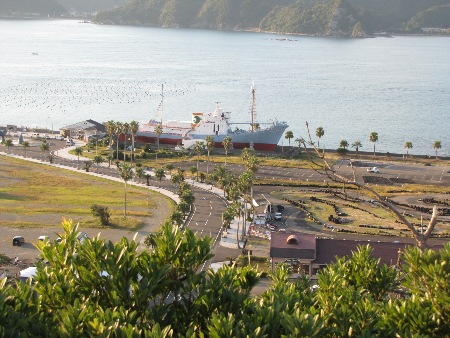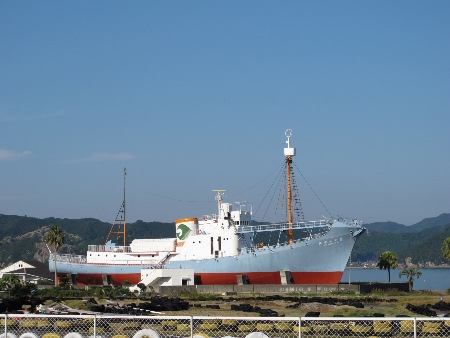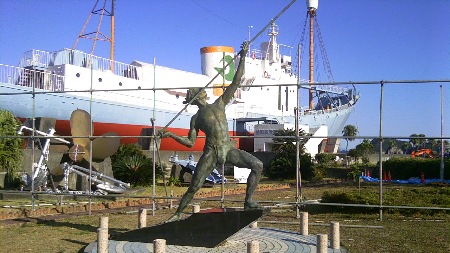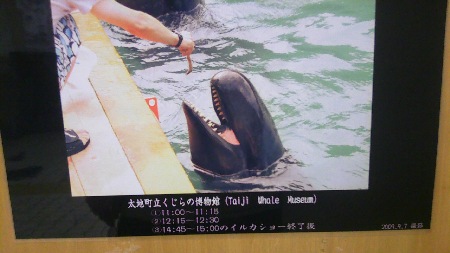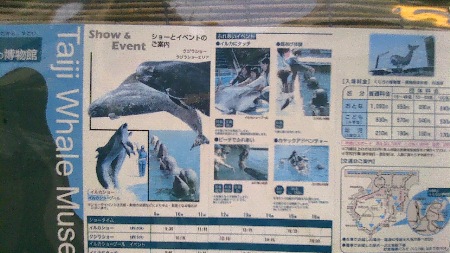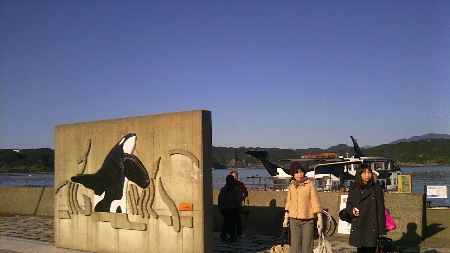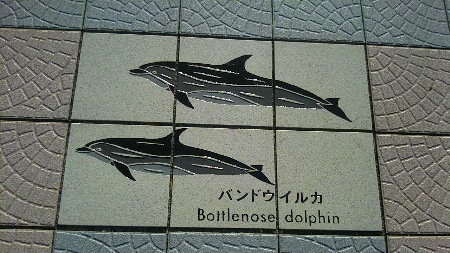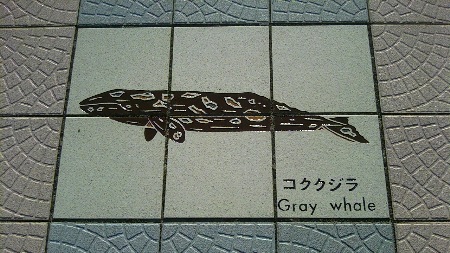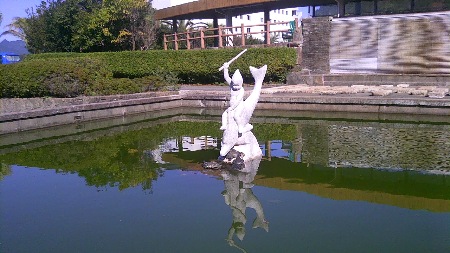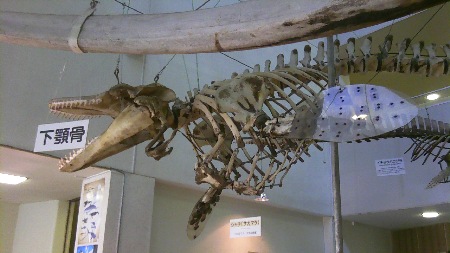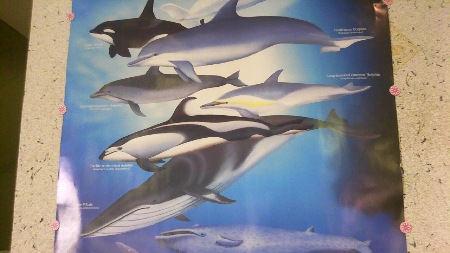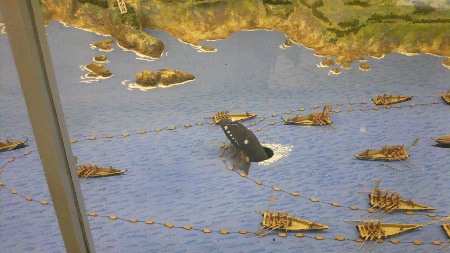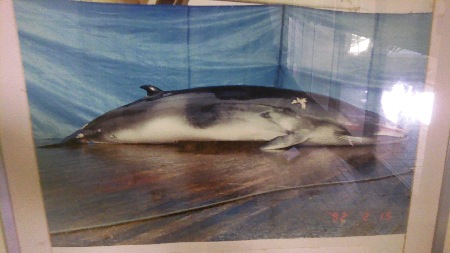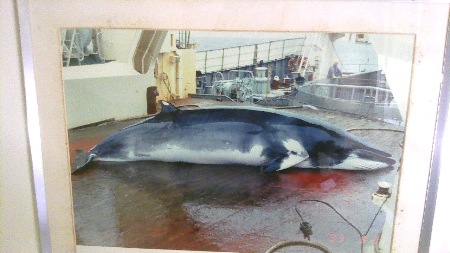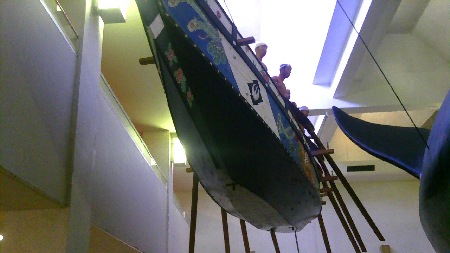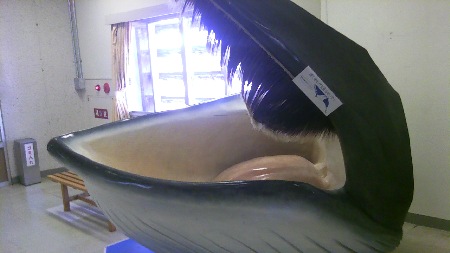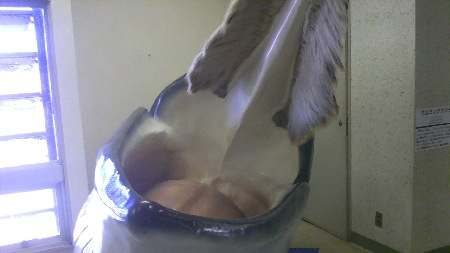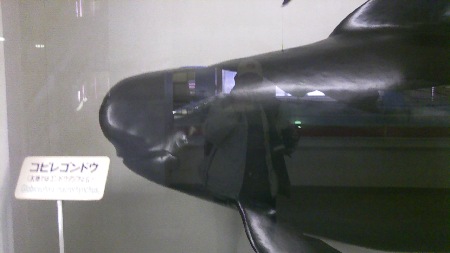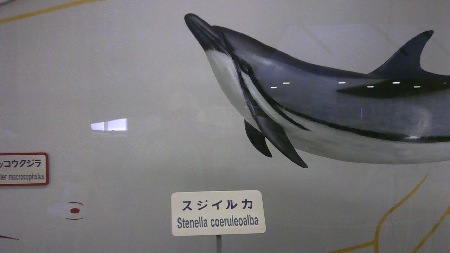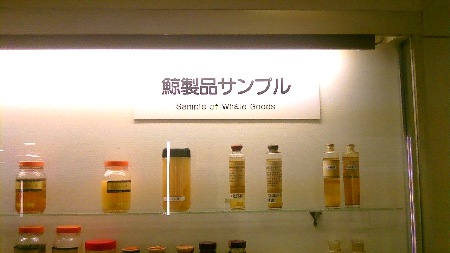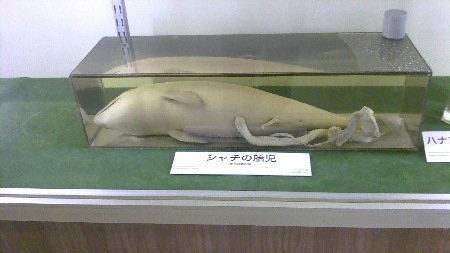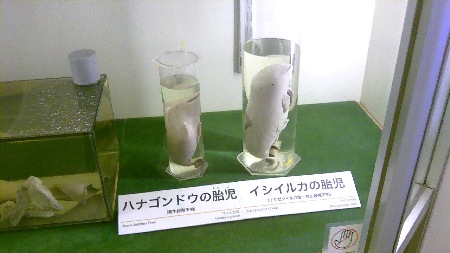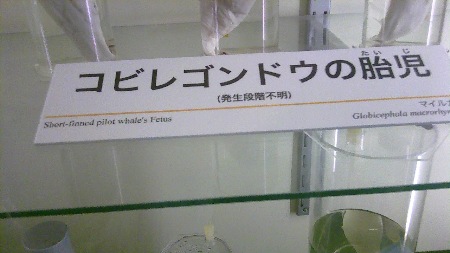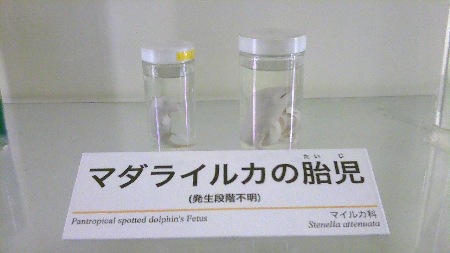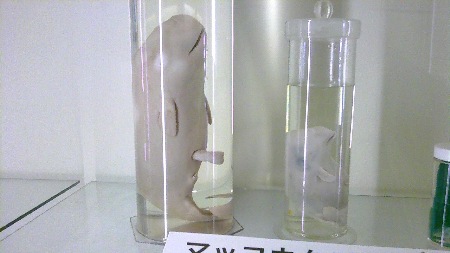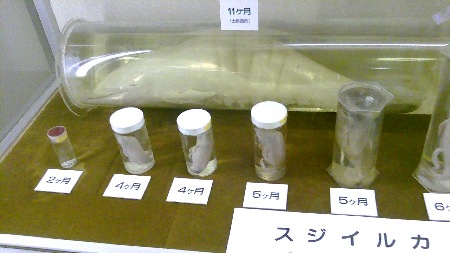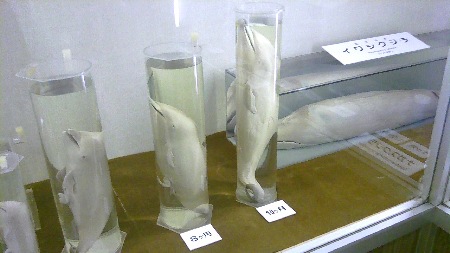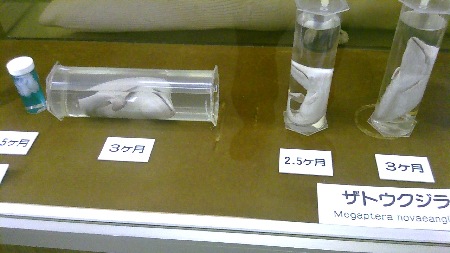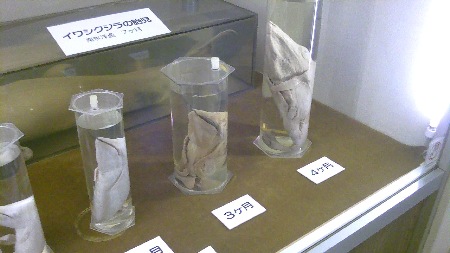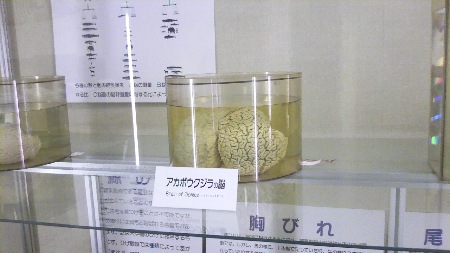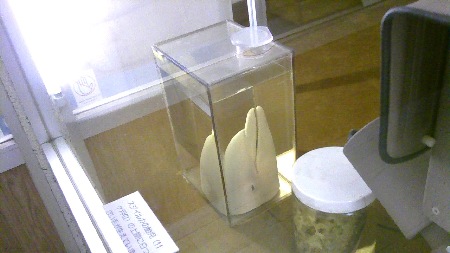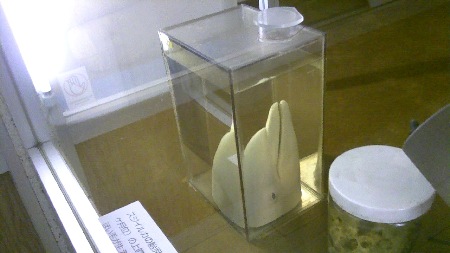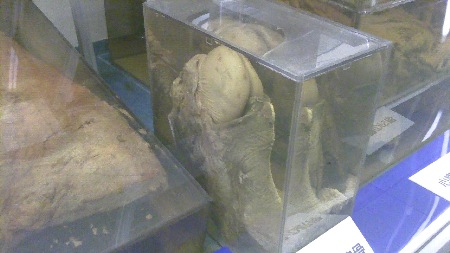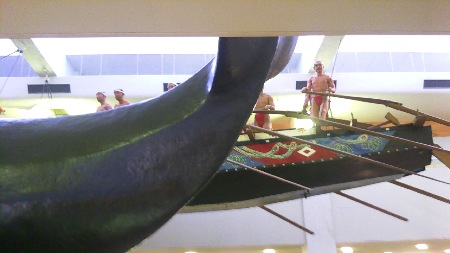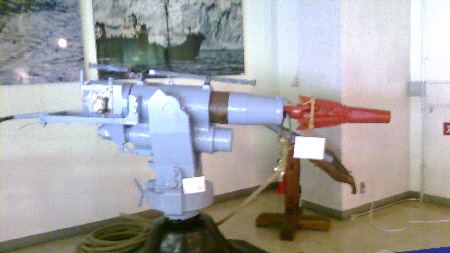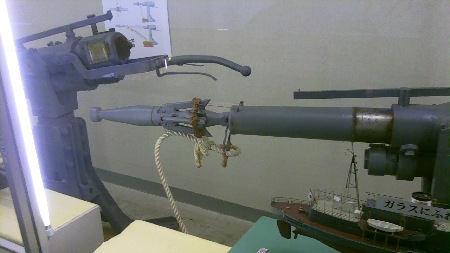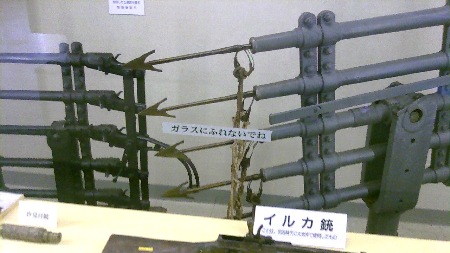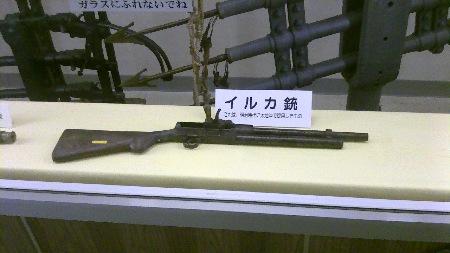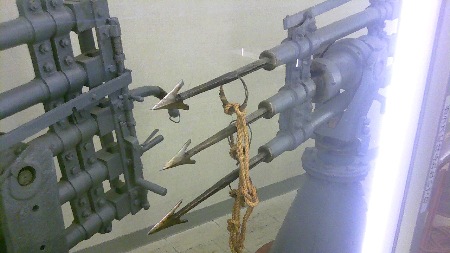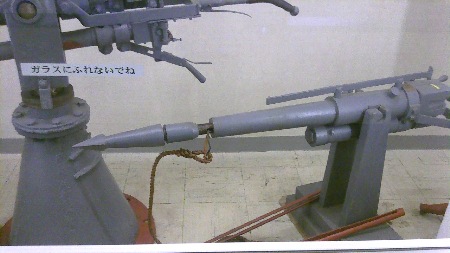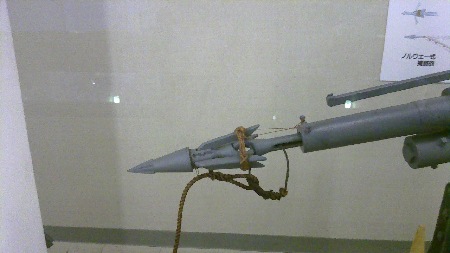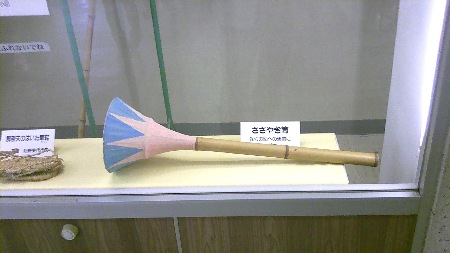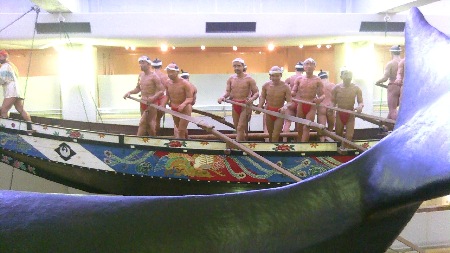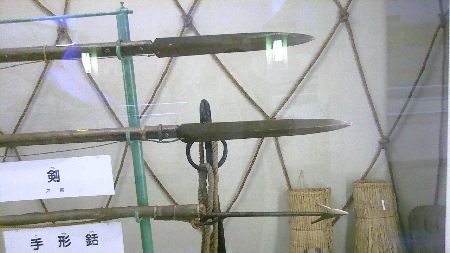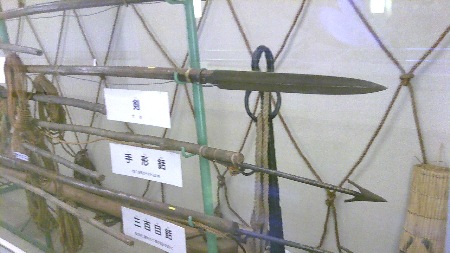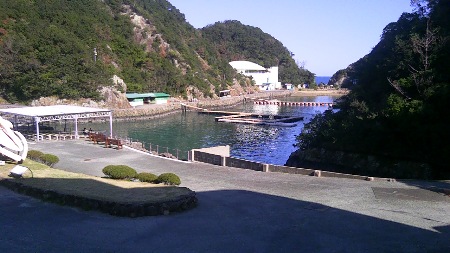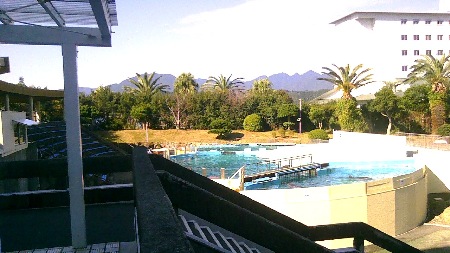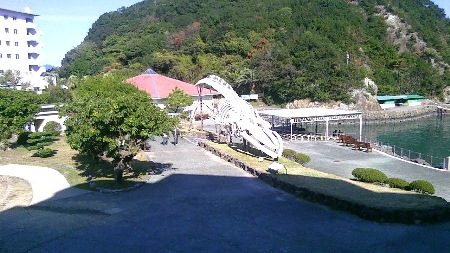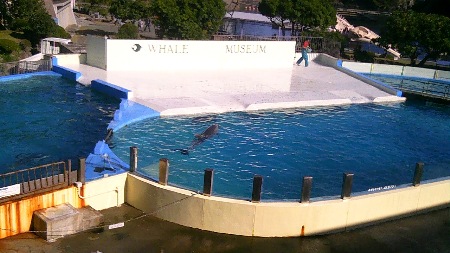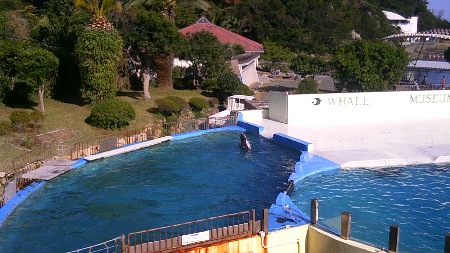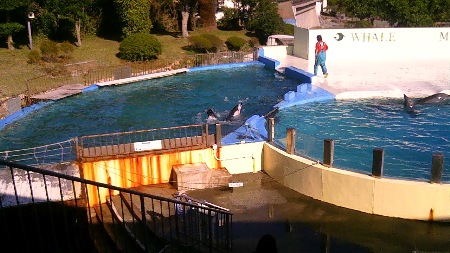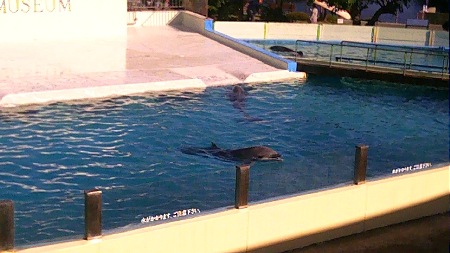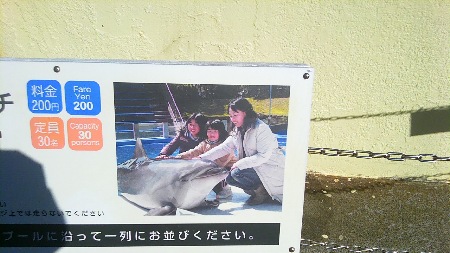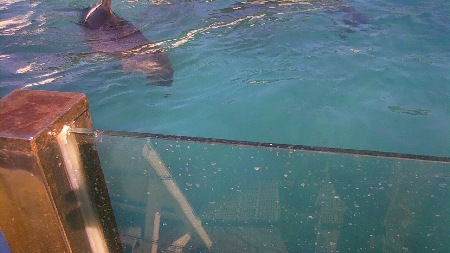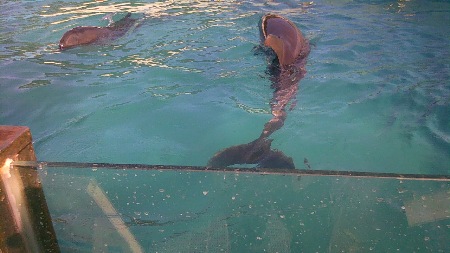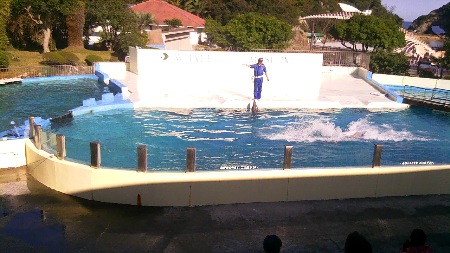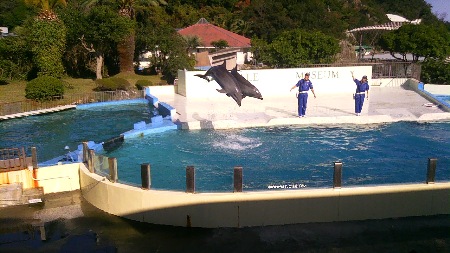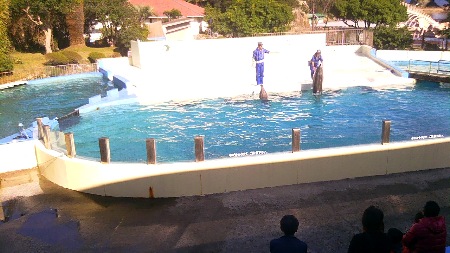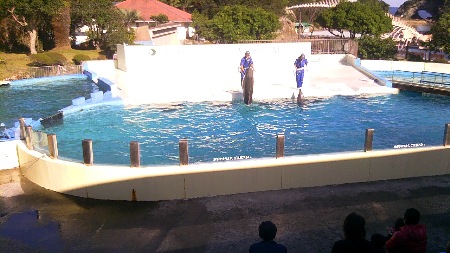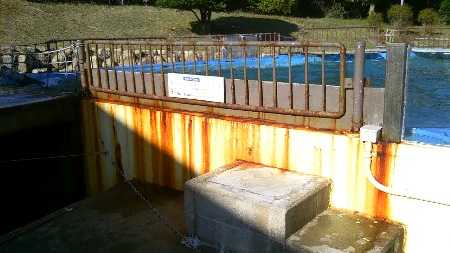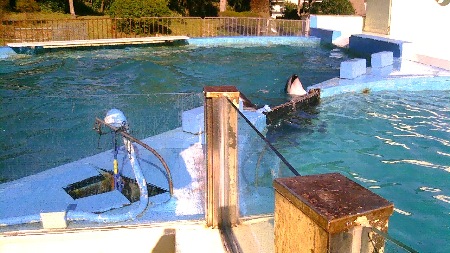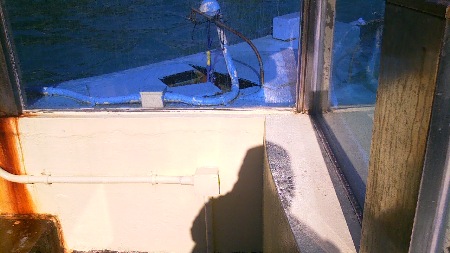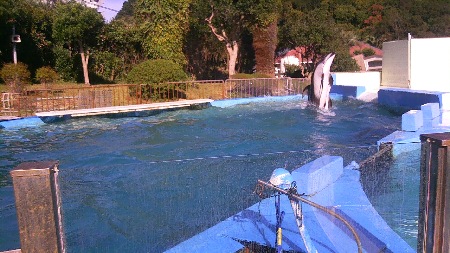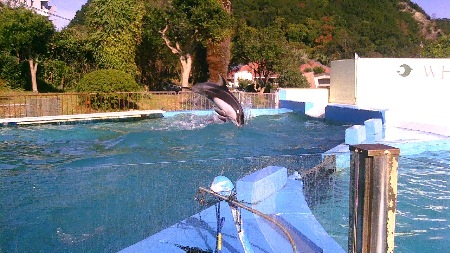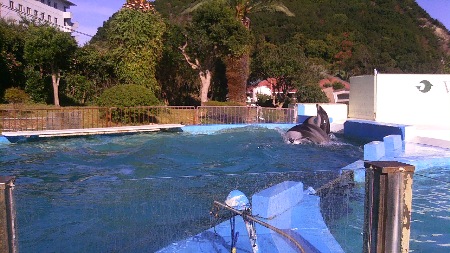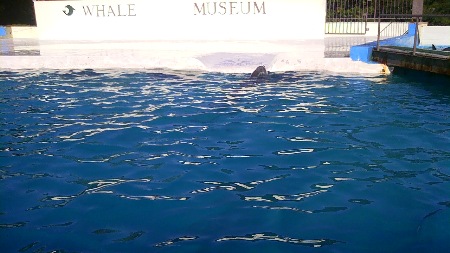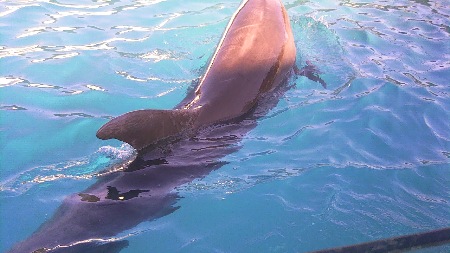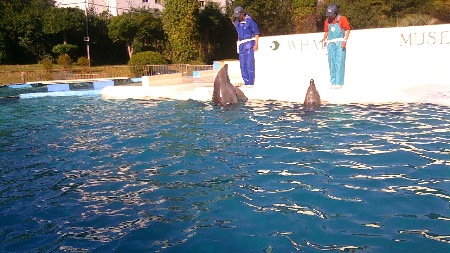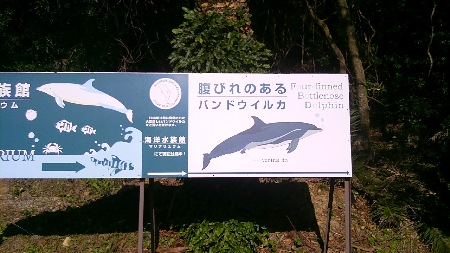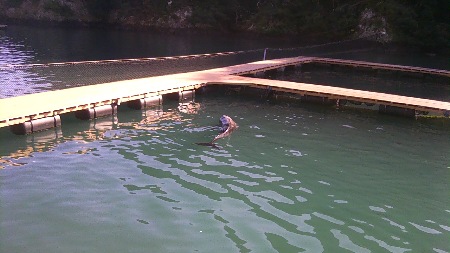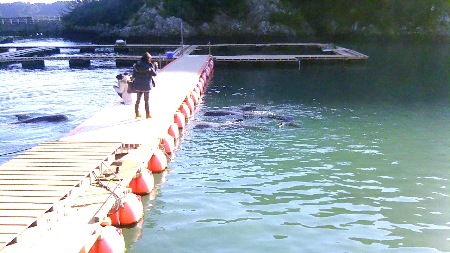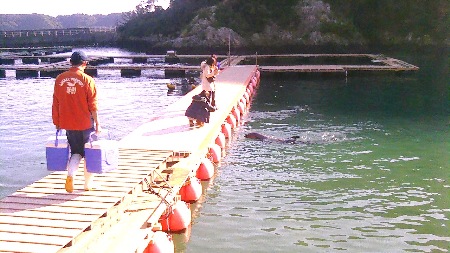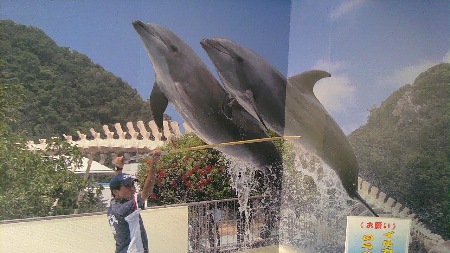

|


Der Name "Walmuseum" täuscht über diese Anlage in Taiji hinweg und ist mehr als irreführend. Sicherlich ist ein Museum in der Anlage untergebracht, welches über die Geschichte des japanischen Delfin- und Walfangs informiert.
Das hauptsächliche Geschäft liegt jedoch im weltweiten Handel mit Delfinen für Delfinarien in aller Welt.
Sie werden an Delfinarien, u.a. in Japan, Ägypten, Türkei, Dubai, Hongkong, Südkorea und Taiwan verkauft. Auch Sea World und das amerikanische Militär kauften in der Vergangenheit Delfine aus Taiji!
Im Walmuseum bekommen die wildgefangenen Delfine ihren "letzten Schliff" bevor sie für Summen von bis zu 150.000 Dollar verkauft werden.
ProWal/WDSF-Video - Tierquälerei in Japan - Taiji Whale Museum - der größte Delfinhändler der Welt - http://www.youtube.com/watch?v=PYqPusgE-Kc&feature=email
Blick vom Walmuseum auf ein stillgelegtes Walfangschiff
Whale Museum in Taiji
The name “Whale Museum” is really deceiving. Certainly there is a museum in this facility, which tells you about the history of the Japanese whale and dolphin hunt.
But the most important business is the worldwide trade in dolphins and the sale of dolphins to dolphin shows.
Dolphins are being sold to show places in Japan, Egypt, Turkey, Dubai, Hong Kong, South Korea and Taiwan. Even Sea World and the American military bought dolphins from Taiji in the past.
The dolphins receive their last touches here at the whale museum before they are sold for sums up to $ 150.000.
View from the Whale Museum - a mothball whaling ship
Überall wird hier die Fütterung der Tiere hervorgehoben. Besucher können gar für wenig Geld zu vorgeschriebenen Zeiten selbst die eingesperrten Delfine füttern. In Wahrheit steckt hier ein knallhartes Abrichten und eine Fügigmachung auf dem Programm. Die Tiere bekommen nur Futter, wenn sie gewisse Kunststücke vorführen.
All over the feeding of the dolphins is being stressed. Visitors can themselves feed the captive dolphins for a little money at certain times. In reality, though, this is part of a very hard and calculated training program to subdue the dolphins. The animals are only fed in return for performing certain tricks.
Touristenboote aus der Nachbarstadt Kii-Katsuura bringen Besucher zum Walmuseum...
Boats carrying tourist from the neighboring town Kii-Katsuura visit the whale museum...
Vor dem Walmuseum eine Skulptur - ein Mensch reitet auf einem Delfin - in der Hand ein Stock...
A sculpture in front of the whale museum - a boy riding on the back of a dolphin - a stick in his hand ...
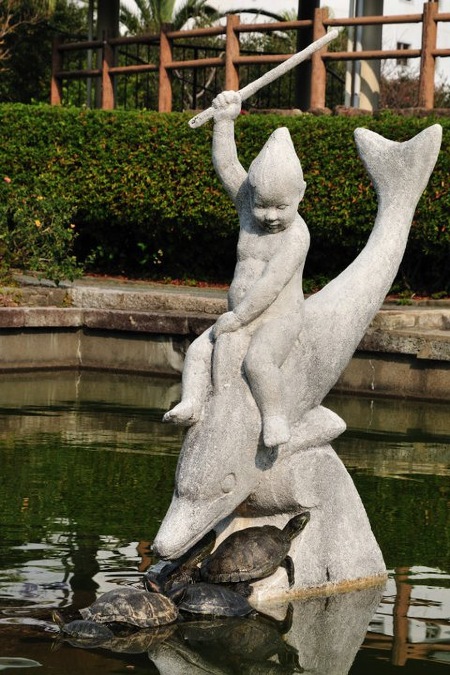
In der Anlage ist ein Gebäude mit einem Museum untergebracht...
The grounds include a building with a museum ...
Stolz zeigt man die Geschichte des Walfangs....
Proudly the history of the whale hunt is being displayed...
Produkte, die aus Walen gewonnen wurden...
Products that were made from whales...
Horror pur!
Ungeborenes Leben konserviert...
Orca-Fötus...
A pure horror story!
Conserved unborn life ...
Orca-fetus ...
Das Gehirn eines Meeressäugers...
The brain of a marine mammal ...
Delfinarienbetreiber heben nach Kritik oftmals hervor, dass es den Delfinen in Delfinarien gut geht. Das sieht man ja an ihrem Lächeln. Dieser Delfin lächelt auch noch. Delfine haben immer den Ausdruck eines Lächelns im Gesicht, weil ihre Gesichtsmuskulatur, anders als beim Menschen, nicht veränderbar ist.
Being criticized, the owners of dolphins shows often maintain that the dolphins are happy in their concrete environment. “You can see it by their smile”. This dolphin below is still smiling! Dolphins always have a smile on their face because their facial muscles cannot change contrary to the human face.
Die Anlage erschließt sich weiträumig. Im Hintergrund das Meer. Die Meerwasseranlage ist vom Meer getrennt. In dem hellen Gebäude befinden sich acht Große Tümmler, die in einer Art mehrstöckiger Glasanlage untergebracht sind. Hier kam es zu einer besonderen Begegnung.
In der Mitte im Wasser befinden sich schwimmende Pontons, von denen aus die Delfine gefüttert werden. Im linken Vordergrund Sitzplätze für die Vorführungen.
The grounds are spacious. The sea is in the background. The seawater pen is separated from the ocean. There are 8 big bottle-nose dolphins in the white building in the background, which are kept in a glass tank that is a couple of stories high. This is where we had a special encounter. Besondere Begegnung
In the center of the pen are swimming platforms, from where the dolphins are being fed. In the foreground left are seats for the audience.
Wie unter Trainingsbasis Taiji beschrieben, ist diese Anlage hier dafür konzipiert, den wildgefangenen Delfinen einen letzten Schliff für ihr zukünftiges Leben in Delfinarien zu verpassen. Hier befinden sich die Tiere zum ersten Mal in ihrem Leben in einem Betonbecken. Auch machen sie hier zum ersten Mal Bekanntschaft mit chlorhaltigem Wasser, welches in den meisten Delfinarien verwendet wird.
As mentioned under Trainingsbasis Taiji, this facility is the place, where the dolphins caught in the wild will get the last touch-up for their future life in dolphin shows. This is where the animals are kept for the first time in a concrete tank. Furthermore, this is where they get to know chlorinated water, which is used in most dolphin tanks.
Eine Replik eines Blauwalskeletts inmitten der Anlage...
A replica of a blue whale skeleton in the center of the grounds...
In diesem engen Becken sind sieben Delfine eingesperrt! Zudem wurde es noch unterteilt - links befinden sich zwei, in der Mitte zwei und im rechten Bereich drei Delfine, die jeweils keinen Zugang zu den anderen Beckenbereichen haben. Die drei Tümmler im rechten Bereich können sich kaum bewegen. Unter Zwang gewöhnt man die Tiere an die Enge in den Delfinarien.
In this small tank seven dolphins are being kept! To top this, the tank is further divided - on the left hand side there are two, in the middle also two and in the right hand part there are three dolphins, which do not have access to the other parts of the tank. The three bottle-nose dolphins on the right can hardly move around. Under duress the animals are forced to get used to the limited space in the future dolphin tanks.
Hier wird dafür geworben, dass man die Delfine streicheln kann...völlig absurd ist, dass man im Shop des Museums auch das Fleisch der Delfine erwerben und konsumieren kann! Siehe unter Fleischverkauf
Here the public is encouraged to pet the dolphins .. and on the other hand, which is totally absurd ... it is advertised that you can buy and consume dolphin meat in the museum shop. See under Fleischverkauf
Training mit hungrigen Delfinen...
Training of hungry dolphins...
Das Chlor veräzt Augen und Haut der Delfine...
The chlorine burns eyes and skin of the dolphins...
Warten auf Nahrung....
Waiting for food....
Die letzte Zeit im Meerwasser...
The last moments in seawater...
Die antrainierten Delfine finden hier nun eine Umgebung wie in einem Delfinarium vor. Betonwände, Enge, Musikbeschallung, Chlorwasser, toter Fisch als Nahrung, klatschendes Publikum und streichelnde Besucher. Was den Delfinen dann noch genommen wird, ist das Sonnenlicht, welches sie meist nie mehr sehen werden. Neonlicht und grelle Scheinwerfer sollen dann die Sonne simulieren. Toter Fisch wird deshalb verwendet, weil es oftmals nicht erlaubt ist, lebende Fische zu füttern und sich toter Fisch besser dazu eignet, Medikamente beizufügen, weil die Delfine in Gefangenschaft sehr oft an Krankheiten leiden.
Wer Delfinarien betreibt und besucht, sie positiv erwähnt, die sinnlose Delfin-Therapie anbietet und nutzt, an Tauch- und Schwimmprogrammen mit Delfinen in geschlossenen Beckensystemen teilnimmt, ist mitverantwortlich für viel Leid, welches die Tiere in Gefangenschaft erleben müssen.
The pre-trained dolphins will here find the same conditions as in a show tank. Concrete walls, confinement, music and noise, chlorinated water, dead fish for food, applauding people and petting visitors. On top of all that, the dolphins are deprived of sunlight, which most of the time they will never see again. Neon lights and bright spotlights will try to imitate the sunlight. Dead fish is fed to the dolphins because it is not permitted to feed live fish and dead fish is better suited for dispensing medication, because dolphins in captivity are often plagued by diseases.
Whoever owns or even visits dolphins in captivity, mentions this fact in a positive manner, offers senseless dolphin-therapy or uses such, whoever participates in swim-programs with dolphins in enclosed tanks is also responsible for their suffering in captivity.










































































